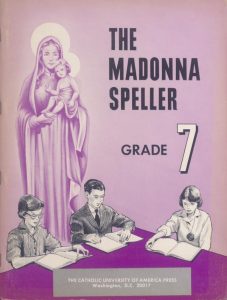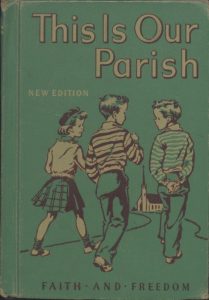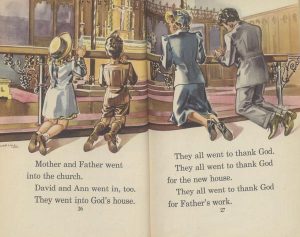
This week’s post is guest-authored by Austin Arminio, a graduate student in the field of Library and Information Science.
For the past three months, I worked on a project to digitize publications of the Commission on American Citizenship of The Catholic University of America. During the 1938 Golden Jubilee of The Catholic University of America (CUA), Pope Pius XI sent a letter of congratulations to the American hierarchy. In this letter, he also gave the church leaders an assignment to create a curriculum for Catholic school students giving special attention to civics, sociology, and economics. The Bishops heeded the call, prompting CUA to create the Commission on American Citizenship. The Commission’s goal was to develop a school curriculum that educated elementary students on how to be both good American citizens and moral Catholics.

The Commission, founded by CUA faculty members Fr. Joseph M. Corrigan, Msgr. Francis J. Haas, and Msgr. George Johnson, went about creating textbooks to educate children on American history, literature, mathematics, citizenship, and Christian morals. Some of these works, such as the Madonna Speller series, would not be out of place in a public school, teaching writing, grammar, and spelling; while others like Faith and Our Freedom: This is Our Parish, dealt exclusively with Catholic religious teachings and how they apply to everyday life. Some books contained messages that were considered astonishing for their time. Faith and Freedom: These are Our People has the story of Eddie Patterson inviting his Chinese-American and African-American friends to his birthday party. While some of the language would be considered stereotypical today, CUA archivist Dr. Maria Mazzenga notes that at the time of the books publishing, Jim Crow and the Chinese Exclusion Act were still enforced.
During my time on this project, I was glad for the opportunity to create metadata and use a digital document repository such as Islandora, the software used by the Washington Research Libraries Consortium (WRLC). I had previously only worked with the scanning of documents, leaving the later steps to others, so it was interesting to deal with this part of the archival process. While it was time-consuming and required attention to detail using coding systems such as HTML and XML, the overall process was fairly simple. I believe that alone is an important and vital part of digital archiving. If these systems are to be adopted by libraries and archives, it is vital they be easy to use by both those who create them and those who use them for research.

At the same time, this project made me painfully aware of the limitations of digital technology. This project, which only involved scanning 19 works, the longest of which was around 250 pages, took me almost three months to complete. In contrast, the actual creation of metadata and uploading the files to Islandora only took around two days. While obviously larger digitization projects would involve more than just one person working on scanning, it is clear to me time and resources are the main obstacles for digital archiving. To remedy this, institutions might instead benefit by only focusing on certain collections for online digitization. Those items that are most visually interesting, such as the brightly colored and illustrated CAC texts, are some of the best candidates for digitization, as they are likely to draw attention and interest to the larger collection.

What a great resource! We often have patrons who look for items like these; we’ll be happy to let them know about your project!
Who could not enjoy these readers as a child! I know I did. I read early but tried to keep it a secret from my parents. The methods used in Faith and Freedom gave me the limited skills I needed to guide five of my siblings to be able to read early.
The stories were engaging and informative, from the daily lives of David, Ann, and Timmy in first grade, to classics and Reader’s Digest stories in the eighth. I later discovered there were other publishers of Catholic basal readers. Scott Foresman, the publishers of the famous Dick and Jane, gave it a go with the Cathedral Reading Series. Cathedral, to my mind, was simply not as enjoyable reading as Faith and Freedom.